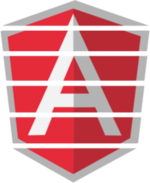Add server-side pagination to any list or table on the page. This directive connects a variable of your choice on the local scope with data provied on a given URL. It provides a pagination user interface that triggers updates to the variable through paginated AJAX requests.
Pagination is a distinct concern and should be handled separately from other app logic. Do it right, do it in one place. Paginate anything!
Include with bower
bower install angular-paginate-anythingLoad the javascript and declare your Angular dependency
angular.module('myModule', ['begriffs.paginate-anything']);Then in your view
<!-- elements such as an ng-table reading from someVariable -->
<begriffs.pagination collection="someVariable" url="'http://api.server.com/stuff'" />The pagination directive uses an external template stored in
tpl/paginate-anything.html. Host it in a place accessible to
your page and set the template-url attribute (see below).
- Attaches to anything — ng-repeat, ng-grid, ngTable etc
- Server side pagination scales to large data
- Works with any MIME type through RFC2616 Range headers
- Handles finite or infinite lists
- Negotiates per-page limits with server
- Keeps items in view when changing page size
- Twitter Bootstrap compatible markup
Your server is responsible for interpreting URLs to provide these
features. You can connect the url attribute of this directive
to a scope variable and adjust the variable with query params and
whatever else your server recognizes. Changing the url causes the
pagination to reset to the first page and maintain page size.
This directive decorates AJAX requests to your server with some simple, standard headers. You read these headers to determine the limit and offset of the requested data. Your need to set response headers to indicate the range returned and the total number of items in the collection.
You can write the logic yourself, or try a pre-made library like begriffs/clean_pagination.
For a reference of a properly configured server, visit pagination.begriffs.com.
Here is an example HTTP transaction that requests the first twenty-five items and a response that provides them and says there are one hundred total items.
Request
GET /items HTTP/1.1
Range-Unit: items
Range: 0-24Response
HTTP/1.1 206 Partial Content
Accept-Ranges: items
Content-Range: 0-24/100
Range-Unit: items
Content-Type: application/json
[ etc, etc, ... ]In short your server parses the Range header to find the zero-based
start and end item. It includes a Content-Range header in the
response disclosing the range it chooses to return, along with the
total items after a slash, where total items can be "*" meaning
unknown or infinite.
To do all this header stuff you'll need to enable CORS on your server.
In a Rails app you can do this by adding the following to config/application.rb:
config.middleware.use Rack::Cors do
allow do
origins '*'
resource '*',
:headers => :any,
:methods => [:get, :options],
:expose => ['Content-Range', 'Accept-Ranges']
end
endFor a more complete implementation including other appropriate responses see my clean_pagination gem.
- Hypertext Transfer Protocol (HTTP/1.1): Range Requests
- RFC2616 Section 3.12, custom range units
- Beyond HTTP Header Links
Thanks to Steve Klabnik for discussions about doing hypermedia/HATEOAS right, and to Rebecca Wright for reviewing and improving my original user interface ideas for the paginator.

